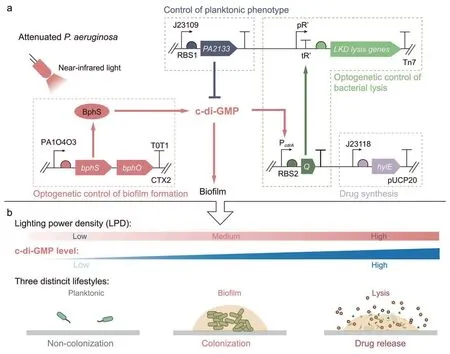Genetically Engineered Bacteria Offer New Hope in Cancer Treatment
By YAN Fusheng (Staff Reporter)
Through innovative genetic engineering, CAS scientists from the Shenzhen Institutes of Advanced Technology (SIAT) have successfully devised a ‘remote control’system for bacteria using near-infrared light.By modulating the intensity of this light, they can prompt the bacteria to cycle through three distinct states: free-floating, colony formation, or self-destruction with the accompanying release of therapeutic agents.This groundbreaking approach ushers in a novel concept in cancer treatment that leverages the intricate biology of bacteria.

By rewiring the bacteria’s genetic circuits, scientists create a “remote control”for bacteria using near-infrared light.When adjusting the light’s intensity, they can switch bacteria between three modes: floating freely, forming colonies, or breaking apart to release drugs, forming a new concept for cancer treatment.(Image by SIAT)
Imagine deploying an army of microscopic soldiers,each armed with a specific weapon, to infiltrate and destroy enemy bases - cancer cells.This is not a sci-fi plot, but a real-life strategy being developed by scientists at the Shenzhen Institutes of Advanced Technology (SIAT)of the Chinese Academy of Sciences.
In a recent study published in theNational Science Review, the team, led by Dr.JIN Fan and Dr.ZHANG Rongrong, unveiled a novel cancer-fighting method called bacteria-mediated cancer therapy (BMCT).This technique uses genetically engineered bacteria, controlled by near-infrared light (NIR), to target and destroy tumors.
The researchers have devised a ‘genetic circuit’– a set of instructions that dictate the bacteria’s behavior.By adjusting the intensity of NIR light, they can switch the bacteria between three modes: freely floating, forming colonies, or breaking apart to release drugs.This lightcontrolled approach allows for precise manipulation of the bacteria, offering a non-invasive method to control these bacterial genetic circuits within the body.
“Tumor invasion, colonization, and regression are key biological events in BMCT,”the researchers explain.“By controlling these events, we can greatly improve the therapeutic efficacy of the treatment.”
The unique, low-oxygen environment of solid tumors, which often hinders many cancer therapies,is ideal for the colonization and proliferation of certain bacteria, includingListeria,Clostridium, andSalmonella.These bacteria have been extensively used in cancer treatment, and their behaviors can now be controlled more precisely with this new method.
While the use of genetically modified bacteria might raise safety concerns, the researchers emphasize that the bacteria used in this therapy are carefully engineered and controlled.The treatment is designed to be highly targeted, reducing the risk of unwanted side effects.
“The deep tissue penetration of NIR offers us a modality for spatio-temporal and non-invasive control of bacterial genetic circuitsin vivo,”explain the researchers.“Our results showed that programming intratumoral bacterial lifestyle transitions allows precise control of multiple key steps throughout the BMCT process and therapeutic efficacy can be greatly improved by controlling the localization and dosage of therapeutic agents via optimizing the illumination scheme.”
This innovative approach to cancer treatment,which allows for precise control of therapeutic agents,offers new hope for patients with hard-to-treat tumors.
While more research is needed to fully understand and optimize this approach, the results so far are promising.As we continue to explore the microscopic world, we may find that some of our most effective weapons against cancer are smaller than we ever imagined.
 Bulletin of the Chinese Academy of Sciences2023年1期
Bulletin of the Chinese Academy of Sciences2023年1期
- Bulletin of the Chinese Academy of Sciences的其它文章
- Exercise: The Fountain of Youth at a Cellular Level
- How SARS-CoV-2 Hijacks Our Immune Cells
- Stretchy Electronic Devices Assembled in a Lego-like Way
- Engineering Crops to Thrive on Sodic Lands
- Gene Editing Restores Hearing in Mice
- Gene Editing Offers New Hope for Treating Huntington’s Disease
